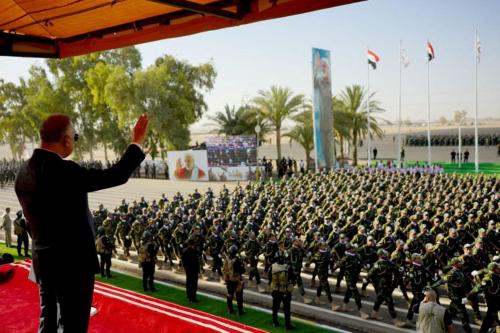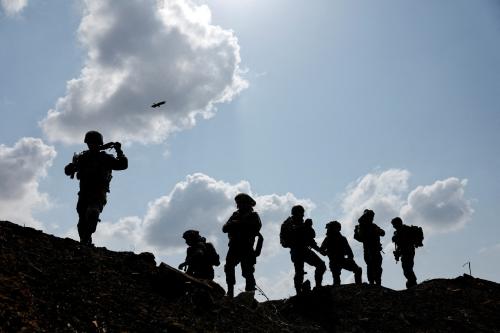Content from the Brookings Doha Center is now archived. In September 2021, after 14 years of impactful partnership, Brookings and the Brookings Doha Center announced that they were ending their affiliation. The Brookings Doha Center is now the Middle East Council on Global Affairs, a separate public policy institution based in Qatar.
Somalia’s infamous image in the international media last year resulted from not only Somali-based piracy in the Indian Ocean, but the country’s poverty, endemic civil strife and the increasing influence of Al Qaeda in the Horn of Africa.
Will 2010 see Somalia become Africa’s version of the Taliban’s Afghanistan, or can the world come together to promote stability and human development in this country that has suffered too long?
There have been 14 failed attempts to establish a functioning government in Somalia since 1991, and since 2007, fighting in Southern Somalia has killed some 19,000 civilians and displaced 1.5 million people — approximately 15 percent of the population. In January 2009, a power-sharing agreement created a broad-based transitional federal government (TFG) led by moderate religious groups under President Sheikh Sharif Sheikh Ahmed, with support from the United States and many other countries. Although this government may be the best hope for Somalia after almost two decades of unrest, the TFG is embroiled in a fierce military struggle to maintain control against Al Shabaab (a powerful and uncompromising militant religious group with links to Al Qaeda) and Hizbul Islam (a less powerful militant religious group seeking to oust foreign troops from Somalia and overthrow the TFG).
The government’s foes
Some call Al Shabaab Al Qaeda’s proxy in Somalia. In September 2009, a double suicide car bombing at the United Nations base in Mogadishu killed the deputy commander of the force and at least 15 others; Al Shabaab claimed responsibility. According to the United Nations Special Representative to Somalia, Ahmedou Ould-Abdallah, foreign recruits, such as Al Qaeda and Taliban members, and other experienced foreign combatants are fighting alongside Somali militants to overthrow the government and establish a caliphate, or Islamic rule, based on a harsh interpretation of Muslim religious law.
The internationalization of the Somali conflict has also occurred through Somali involvement in a foiled terror plot in Australia this past summer and Somali-American youth returning to Somalia to join Al Shabaab. Among these Somali Americans turned insurgents was the first American suicide bomber who carried out attacks in northern Somalia last year that killed 30 people. To add to this bedlam, although the Ethiopian army’s two-year military presence in Somalia officially ended January 2009, they have conducted multiple raids in Somalia over that past several months. These repeated incursions further strengthen hardliners like Al Shabaab, who fashion themselves as nationalists. In September 2009, the American military undertook a surgical military strike to eliminate Saleh Ali Saleh Nabhan, an Al Shabaab associate who is said to be one of the most dangerous Al Qaeda leaders in Africa, and mastermind of the 2002 Paradise Hotel attack in Mombasa which killed 11 Kenyans and three Israelis.
Religious militant groups like Al Shabaab and Hizbul Islam have, at minimum, the potential to wreak havoc in Somalia and may indeed be capable of overthrowing the government. On December 3, 2009, a suicide bombing at a medical school graduation killed 3 ministers — of health, education and higher education — alongside some 15 others. A major blow to the TFG, the bombing demonstrated how ill-equipped the government is to protect its own civilians. Although the 5,000 plus members of the African Union Mission to Somalia (AMISOM) — the active peacekeeping mission supported by the UN — have a defensive mandate, the troops have been commissioned with implementing a national security plan and training Somali security forces, and must shore up efforts to do so.
The root of the problem
With more than 70 percent of Somalis living on less than $2 per day, and food prices soaring, its no surprise that young Somali men are latching on to those who can provide for them and their families — in many cases militant religious organizations such as Al Shabaab. Reportedly, the group offers young Somali men a steady income of $150 per month — a rare chance at economic stability. While measures to improve the economic situation in Somalia are required, these efforts are obviously long-term. Meanwhile, short-term efforts are needed to alleviate the dire pressures Somali youth are subjected to. For example, although tiny in size, in 2009, the Yemeni government granted 90 Somali students scholarships and these students moved to Yemen to pursue their education. If every Arab country were to grant 250 scholarships to Somali youth, some 5,000 young Somalis per year could seek brighter futures in near-by countries; this would generate momentum in Somali society and give youth an alternative to piracy or religious militancy.
A pirate’s option
Piracy is another income-generating activity to which many Somali youth have resorted, to the detriment of international maritime security and commerce. Piracy is primarily a separate phenomenon from the militant religious groups that seek to topple the government, but the pirates (and their external financers from Miami to Geneva) are taking advantage of the chaos in Somalia for their business purposes. The International Maritime Bureau reports that the first nine months of 2009 witnessed more pirate attacks than all of 2008. Somali pirates are responsible for more than half of these, launching some 170 attacks in 2009; of these attacks, 47 vessels were successfully hijacked. As of December 2009, about a dozen ships and 250 crewmembers were being held in Somalia. Somali pirates operate with high capability due to sophisticated communication technologies and the prolific availability of small arms within the country. Over the summer, monsoon winds slowed attacks off the Somali coast, but in mid-September attacks recommenced. Piracy will continue to flourish off Somalia’s coast because the industry sustains whole villages and provides livelihoods for destitute Somalis with nothing to lose.
Opportunities in the year to come
Is the TFG the best potential route to stability in Somalia? For now, no other option is on the table. The question is: what can the international community do to bolster the TFG’s tenuous hold on power and bring enough stability for piracy to be controlled and allow human development to begin? The answer lies in political and economic institution-building, good governance and sustainable development promotion, encouragement of peaceful and non-violent communities, maintaining senior level engagement with the TFG, and appointing a Special Envoy to the Horn of Africa.
The US and the broader international community have encountered setbacks while providing the Somali government with humanitarian aid. For instance, in October of 2009, the US deferred the delivery of $50 million-worth of food aid because of concern that Al Shabaab was intercepting assistance. This example attests to the general fragility of aid allocation in Somalia because it is a hostile environment for aid workers. Therefore local contractors — who are more prone to corruption — are trusted with millions of dollars, which has led to reluctance among international aid donors. President Ahmed says that less than $5 million of the $200 million promised at the UN sponsored donors conference held last April have been provided. In order to boost donor confidence, the TFG has set up an anti-corruption committee to investigate any mishandling of state funds. The US and the Arab World, along with other donors, should endorse this anti-corruption body to ensure its success.
Short-term counter-terrorism measures, like the removal of Al Qaeda operatives such as Nahban, are useful, but the international community should invest in capacity-building to strengthen local political and economic institutions by allocating more aid to initiatives that focus on sustainable development and promote good governance in the country; this would certainly work to stem the tide of terrorism in the long-term.
With regard to Somali piracy: while US military drones operating nearby from Seychelles offer formidable deterrence against piracy, they are not a durable solution to the problem. Since Somalis are willing to die in pursuit of livelihoods, the global community must take a grassroots approach and work with existing local authorities who are connected to local communities to advocate alternative methods of sustenance.
The international community must acknowledge and financially empower local communities throughout Somalia that are committed to peace and have developed non-violent mechanisms to resolve local conflicts. This approach can help prevent the spillover effect from the wars in south-central Somalia, and dissuade these communities from embracing Al Shabaab’s ideas or sympathizing with terrorism.
Meanwhile, considering the complex regional dynamics and interlaced set of problems faced by Somalia and the Horn of Africa at large, the US may also want to consider appointing a special envoy for the Horn of Africa.
Thus far international diplomatic support for the TFG has not been sufficient, stakeholders such as the US and Arab states must maintain consistent engagement at senior levels with the transitional federal government in Mogadishu. In August of 2009, US Secretary of State Hillary Clinton met with Somali President Ahmed in Nairobi in a show of solidarity, but more is needed.
Being cynical is not the answer
Cynicism about Somalia on the part of the international community will not solve problems. Should the TFG fail, there is a good chance that Somalia will slip into even deeper anarchy, which would allow Al Qaeda-inspired militant religious groups to develop an even stronger base in the Horn of Africa, from which they could once again threaten population centers around the world. Given the loss of blood and treasure in Afghanistan, this is an outcome the international community can ill-afford.
There are reasons to have hope for progress. Some months ago, a rivalry surfaced between Al Shabaab and Hizbul Islam; a divided front ultimately hinders their insurgency. In addition, President Ahmed has said that some members of Al Shabaab and Hizbul Islam have broken away from these groups and joined the TFG. In spite of all the challenges facing Somalia at this critical juncture in the nation’s history, the international community should renew and redouble its commitment to facilitating Somalia’s transition into good and inclusive governance and stability. US Congressman Donald Payne put it best: “A strong government is key to bringing peace to Somalia…and willful negligence is no longer an option.



Commentary
Op-edSaving a Failing State
February 12, 2010